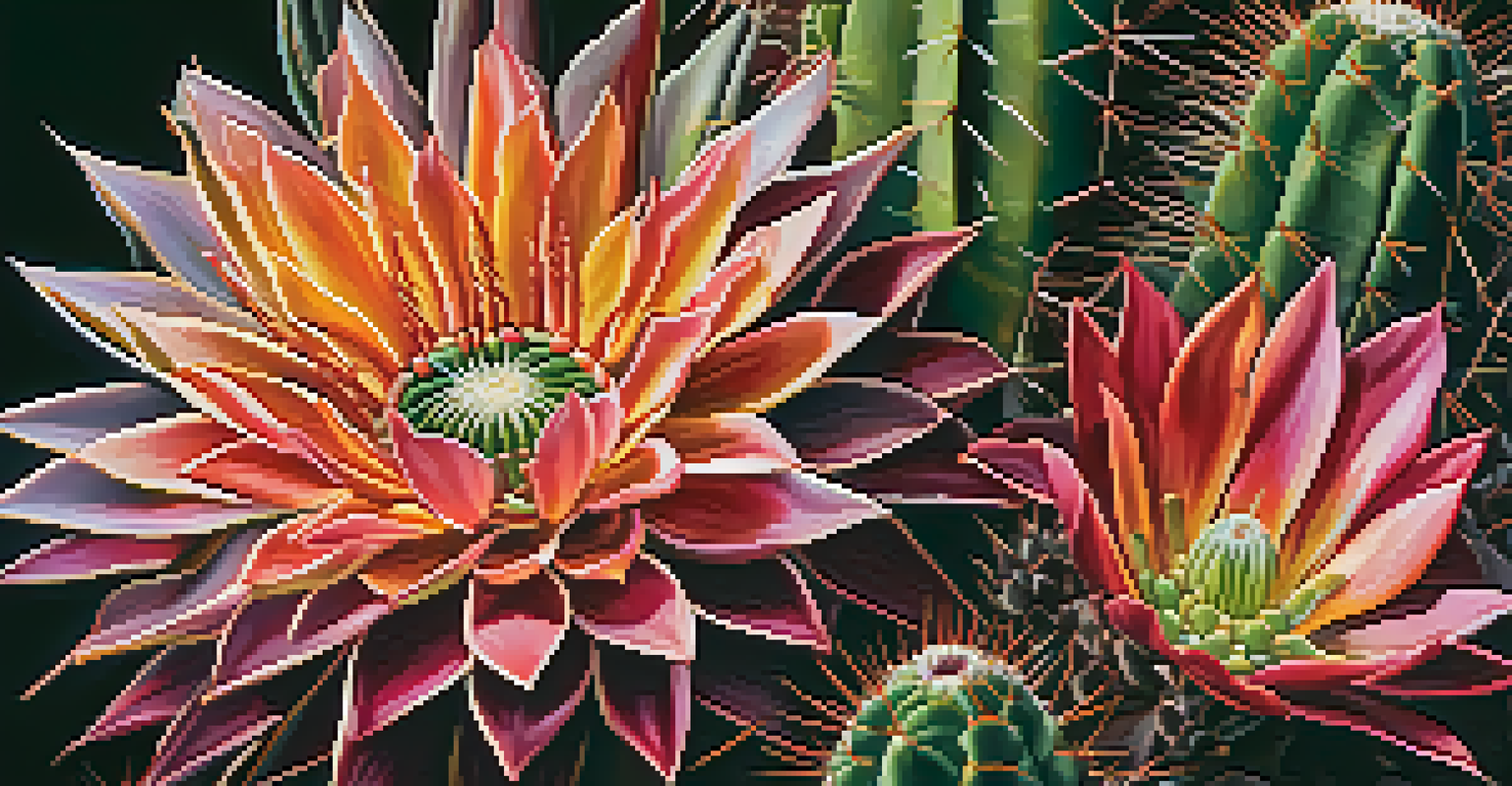Peyote Use in Intertribal Ceremonies: Bridging Cultural Gaps

Understanding Peyote: More Than Just a Plant
Peyote, a small cactus native to the southwestern United States and Mexico, has been used for thousands of years by Indigenous peoples for its psychoactive properties. However, it’s not just a substance; it’s a spiritual tool that helps facilitate connection with the divine. To many, peyote is a sacred gift, often regarded as a bridge between the physical and spiritual realms.
Peyote is a sacred plant that has been used for centuries by Indigenous peoples to connect with the spiritual world.
In various cultures, peyote plays a crucial role in healing rituals and spiritual ceremonies. Participants seek guidance, clarity, and healing through the experiences facilitated by this cactus. It’s important to recognize that its use goes beyond individual experiences and taps into deep-rooted traditions that foster community and connection.
Understanding peyote's significance is essential for appreciating its role in intertribal ceremonies. By viewing it as a cultural cornerstone rather than just a drug, we can better grasp how it serves as a unifying element among different tribes, enriching their collective identities.
Intertribal Ceremonies: A Meeting of Cultures
Intertribal ceremonies often serve as gatherings where different Indigenous groups come together to celebrate and share their cultural practices. These events provide a space for unity, allowing tribes to learn from one another while honoring their unique traditions. The blending of these cultures creates a vibrant tapestry of shared knowledge and experiences.

During these ceremonies, peyote is often central to the rituals conducted. Participants engage in song, dance, and prayer, all while consuming peyote in a respectful and intentional manner. This practice fosters not only spiritual growth but also strengthens intertribal relationships, bridging gaps that may have existed due to historical divisions.
Peyote: A Sacred Healing Tool
Peyote serves as a spiritual tool for Indigenous peoples, facilitating healing and connection during intertribal ceremonies.
The beauty of intertribal ceremonies lies in their ability to transcend boundaries. By emphasizing commonalities and shared beliefs, these gatherings highlight the importance of collaboration and mutual respect among tribes, enhancing their collective cultural heritage.
The Role of Peyote in Healing Practices
Peyote is often used as a healing agent in intertribal ceremonies, both physically and spiritually. Many participants report profound experiences that lead to emotional and psychological healing. This aspect of peyote use showcases its power as a tool for personal transformation, allowing individuals to confront and overcome their struggles.
Cultural exchange is a two-way street, allowing for the sharing of knowledge and traditions while respecting each other's heritage.
In these ceremonies, the collective experience enhances the healing process. Participants support one another in their journeys, creating a safe space for vulnerability and growth. This communal aspect amplifies the effects of peyote, as shared experiences foster deeper connections among participants.
Furthermore, the healing practices surrounding peyote are deeply rooted in Indigenous wisdom. Elders and spiritual leaders guide participants, sharing their knowledge of the plant's significance and the rituals associated with its use. This mentorship not only preserves cultural practices but also emphasizes the importance of community support in the healing journey.
Cultural Appropriation vs. Cultural Exchange
As interest in peyote and Indigenous ceremonies grows, it’s vital to differentiate between cultural appropriation and cultural exchange. Cultural appropriation occurs when elements of a culture are taken without understanding or respect, often leading to commodification. In contrast, cultural exchange is rooted in mutual respect and appreciation, allowing for shared learning and growth.
Intertribal ceremonies exemplify cultural exchange, as they involve active participation and respect for tribal traditions. Those who engage in these ceremonies often do so with the guidance of knowledgeable leaders, ensuring that the practices remain authentic and meaningful. This respectful interaction fosters an environment where cultural heritage is valued and preserved.
Cultural Exchange vs. Appropriation
Understanding the distinction between cultural exchange and appropriation is crucial for respecting Indigenous traditions surrounding peyote.
By participating in intertribal ceremonies, individuals can learn about the significance of peyote and its role in Indigenous cultures. This understanding helps to create a more inclusive narrative, one that honors the traditions and contributions of Indigenous peoples while promoting awareness and respect.
Modern Challenges and Peyote Conservation
As the demand for peyote increases, so do concerns about its conservation. The plant is considered vulnerable due to overharvesting, habitat loss, and climate change. Protecting peyote is crucial not only for the plant’s survival but also for the cultural practices that depend on it.
Many Indigenous leaders advocate for sustainable harvesting practices and the preservation of natural habitats. These efforts aim to ensure that future generations can continue to engage in peyote ceremonies without depleting this sacred resource. By prioritizing conservation, tribes can maintain their traditions while respecting the environment.
Moreover, the conversation around peyote conservation highlights the broader issue of Indigenous rights. The preservation of peyote is tied to the safeguarding of cultural heritage, emphasizing the need for collaboration among tribes, environmentalists, and policymakers. Together, they can work toward a future where peyote thrives, benefiting both the land and the people.
Peyote and the Legal Landscape
The legal status of peyote varies across regions, often creating challenges for Indigenous communities that rely on its use for spiritual practices. In the United States, peyote is classified as a Schedule I controlled substance, which restricts its legal use. However, exemptions exist for members of federally recognized tribes participating in traditional ceremonies.
This legal framework poses both opportunities and challenges, as it allows for the continuation of sacred practices while simultaneously limiting access for some. Advocacy efforts are underway to raise awareness about the importance of peyote in Indigenous cultures and to push for more inclusive policies. These movements aim to protect the rights of Indigenous peoples to practice their traditions without legal hindrance.
Conservation and Indigenous Rights
The conservation of peyote is essential for safeguarding both the plant and the cultural practices that depend on it, highlighting the need for collaboration among communities.
As discussions around drug policy reform continue, it’s crucial to include Indigenous voices in the conversation. Their perspectives can provide invaluable insights into the significance of peyote and the need for policies that respect cultural practices while promoting public health.
Looking Ahead: The Future of Peyote Use
The future of peyote use in intertribal ceremonies is intertwined with the preservation of Indigenous cultures and the respect for their traditions. As more people become interested in Indigenous practices, it is vital to approach these ceremonies with awareness and humility. Understanding the historical context and significance of peyote can help foster a more respectful relationship between cultures.
Continued education about the importance of peyote and intertribal ceremonies can help bridge cultural gaps. By promoting awareness and understanding, we can create a more inclusive narrative that honors Indigenous wisdom and practices. This approach not only benefits the tribes but also enriches the broader cultural landscape.

Ultimately, the future of peyote use will depend on the collective efforts of Indigenous communities, supporters, and advocates. Together, they can ensure that this sacred plant remains a vital part of cultural heritage, promoting healing and connection for generations to come.